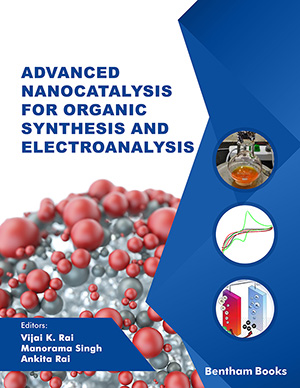
Abstract
Nanocatalysis as an immerging research topic has attracted much attention in the past years. Functionalized materials with a nano-/submicro-dimension displayed a more significant and dramatically powerful catalytic capability than traditional catalysts in organic chemical reactions due to the increased surface area and multiple catalytic centers. Especially, for chiral catalysis and natural product synthesis, nanocatalysts are and will play an important role in enhancing the yield and TON (turn-over number), facilitating the purification and realizing the efficient catalyzation in a recycling manner. This review article aims to conclude the recent proceedings on nanocatalysis, such as catalyst design, construction and modifications, and their applications in organic reactions, particularly to chemo-selective and coupling reactions. Further discussions will outlook the future trends as well as current challenges in this field.
Keywords: Nanocatalyst, organic reactions, construction, modification.
Current Organic Chemistry
Title:Nanocatalysis for Organic Chemistry
Volume: 20 Issue: 19
Author(s): Qien Xu, Yuanhui Song, Yihong Li and Zhe Liu
Affiliation:
Keywords: Nanocatalyst, organic reactions, construction, modification.
Abstract: Nanocatalysis as an immerging research topic has attracted much attention in the past years. Functionalized materials with a nano-/submicro-dimension displayed a more significant and dramatically powerful catalytic capability than traditional catalysts in organic chemical reactions due to the increased surface area and multiple catalytic centers. Especially, for chiral catalysis and natural product synthesis, nanocatalysts are and will play an important role in enhancing the yield and TON (turn-over number), facilitating the purification and realizing the efficient catalyzation in a recycling manner. This review article aims to conclude the recent proceedings on nanocatalysis, such as catalyst design, construction and modifications, and their applications in organic reactions, particularly to chemo-selective and coupling reactions. Further discussions will outlook the future trends as well as current challenges in this field.
Export Options
About this article
Cite this article as:
Xu Qien, Song Yuanhui, Li Yihong and Liu Zhe, Nanocatalysis for Organic Chemistry, Current Organic Chemistry 2016; 20 (19) . https://dx.doi.org/10.2174/1385272820666160215235505
| DOI https://dx.doi.org/10.2174/1385272820666160215235505 |
Print ISSN 1385-2728 |
| Publisher Name Bentham Science Publisher |
Online ISSN 1875-5348 |
Call for Papers in Thematic Issues
Advances of Heterocyclic Chemistry with Pesticide Activity
Global food safety and security will continue to be a global concern for the next 50 years and beyond. Plant diseases have had a significant impact on food safety and security throughout the entire food chain, from primary production to consumption. While conventional chemical pesticides have been traditionally used for ...read more
Carbohydrates conversion in biofuels and bioproducts
Biomass pretreatment, hydrolysis, and saccharification of carbohydrates, and sugars bioconversion in biofuels and bioproducts within a biorefinery framework. Carbohydrates derived from woody biomass, agricultural wastes, algae, sewage sludge, or any other lignocellulosic feedstock are included in this issue. Simulation, techno-economic analysis, and life cycle analysis of a biorefinery process are ...read more
Catalytic C-H bond activation as a tool for functionalization of heterocycles
The major topic is the functionalization of heterocycles through catalyzed C-H bond activation. The strategies based on C-H activation not only provide straightforward formation of C-C or C-X bonds but, more importantly, allow for the avoidance of pre-functionalization of one or two of the cross-coupling partners. The beneficial impact of ...read more
Cutting-edge technology for the development of electrochemical sensors
Electrochemistry based point of care diagnostics is a powerful tool which can revolutionize the current concept of personalize health care industry. There have been several efforts to amalgamate cutting edge technologies (nanotechnology, surface technology, anti-biofouling strategies) while developing assays. The success of each electrochemical sensor is very dependable upon how ...read more
Related Journals
 56
56 5
5 1
1 1
1
- Author Guidelines
- Graphical Abstracts
- Fabricating and Stating False Information
- Research Misconduct
- Post Publication Discussions and Corrections
- Publishing Ethics and Rectitude
- Increase Visibility of Your Article
- Archiving Policies
- Peer Review Workflow
- Order Your Article Before Print
- Promote Your Article
- Manuscript Transfer Facility
- Editorial Policies
- Allegations from Whistleblowers
- Announcements
























